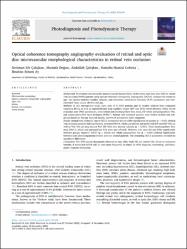| dc.contributor.author | Çalışkan, Neriman Efe | |
| dc.contributor.author | Doğan, Mustafa | |
| dc.contributor.author | Çalışkan, Abdullah | |
| dc.contributor.author | Gobeka, Hamidu Hamisi | |
| dc.contributor.author | Ay, İbrahim Ethem | |
| dc.date.accessioned | 2023-05-05T11:38:22Z | |
| dc.date.available | 2023-05-05T11:38:22Z | |
| dc.date.issued | 2022 | en_US |
| dc.identifier.citation | Çalışkan, N. E., Doğan, M., Çalışkan, A., Gobeka, H. H., & Ay, İ. E. (2023). Optical coherence tomography angiography evaluation of retinal and optic disc microvascular morphological characteristics in retinal vein occlusion. Photodiagnosis and Photodynamic Therapy, 41, 103244. | en_US |
| dc.identifier.issn | 1873-1597 | |
| dc.identifier.uri | https://dx.doi.org/10.1016/j.pdpdt.2022.103244. | |
| dc.identifier.uri | https://hdl.handle.net/20.500.12933/1507 | |
| dc.description.abstract | Background: To evaluate microvascular morphological characteristics of the retina and optic disc (OD) in retinal vein occlusion (RVO) patients using optical coherence tomography angiography (OCTA), compare the results to age- and gender-matched healthy subjects, and determine correlations between OCTA parameters and best-corrected visual acuity (BCVA) and age.
Methods: In this retrospective study, right eyes of 53 RVO patients and 51 healthy subjects were compared regarding BCVA, as well as superficial and deep capillary plexus (SCP and DCP) vessel densities (VDs), foveal avascular zone (FAZ) parameters, outer retinal and choriocapillaris flow areas, OD whole and peripapillary VDs, and retinal nerve fiber layer thickness (RNFLT). Retinal vein occlusion patients were further divided into subgroups based on therapy and risk factors, and OCTA parameters were compared.
Results: Retinal vein occlusion rate or OCTA parameters did not differ significantly by gender (p > 0.05). Retinal vein occlusion patients had significantly decreased BCVA, whole, parafoveal and perifoveal SCP and DCP VDs, as well as VDs 300 µm area around FAZ (FD-300) than healthy subjects (p < 0.001). Their choriocapillaris flow area, RNFLT, whole and peripapillary VDs were also affected. However, FAZ area did not differ significantly between groups. Superior RNFLT (p = 0.016) and whole peripapillary VD (p < 0.001) differed significantly between laser photocoagulation-treated and non-treated patients. The remaining OCTA parameters revealed no significant differences CONCLUSIONS: The RVO and its therapeutic alternatives may affect both OD and retinal VDs. Given its numerous benefits, it seems that OCTA will be used more frequently in clinics for RVO diagnosis, monitoring, and therapeutic response evaluation. | en_US |
| dc.language.iso | eng | en_US |
| dc.publisher | Elsevier | en_US |
| dc.relation.isversionof | 10.1016/j.pdpdt.2022.103244. | en_US |
| dc.rights | info:eu-repo/semantics/embargoedAccess | en_US |
| dc.subject | Microvascular Morphology | en_US |
| dc.subject | Optic Disc | en_US |
| dc.subject | Optical Coherence Tomography Angiography | en_US |
| dc.subject | Retina | en_US |
| dc.subject | Retinal Vein Occlusion | en_US |
| dc.subject | Vessel Density | en_US |
| dc.title | Optical coherence tomography angiography evaluation of retinal and optic disc microvascular morphological characteristics in retinal vein occlusion | en_US |
| dc.type | article | en_US |
| dc.department | AFSÜ, Tıp Fakültesi, Cerrahi Tıp Bilimleri Bölümü, Göz Hastalıkları Ana Bilim Dalı | en_US |
| dc.contributor.institutionauthor | Çalışkan, Neriman Efe | |
| dc.contributor.institutionauthor | Doğan, Mustafa | |
| dc.contributor.institutionauthor | Çalışkan, Abdullah | |
| dc.contributor.institutionauthor | Gobeka, Hamidu Hamisi | |
| dc.contributor.institutionauthor | Ay, İbrahim Ethem | |
| dc.identifier.volume | 41 | en_US |
| dc.relation.journal | Photodiagnosis and Photodynamic Therapy | en_US |
| dc.relation.publicationcategory | Makale - Uluslararası Hakemli Dergi - Kurum Öğretim Elemanı | en_US |
















